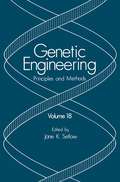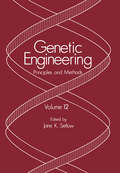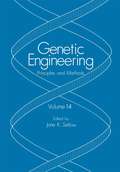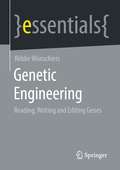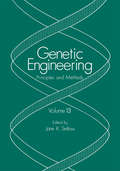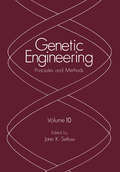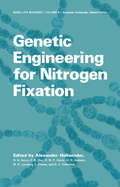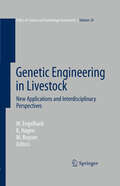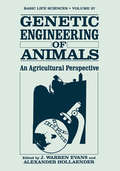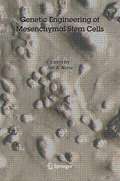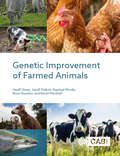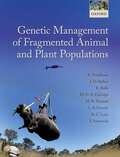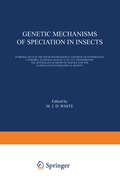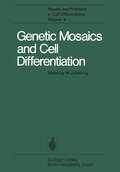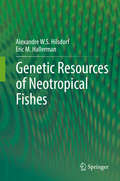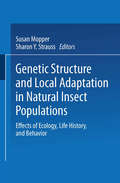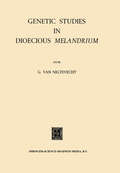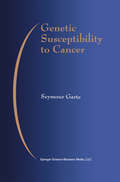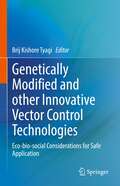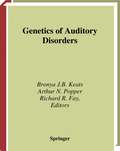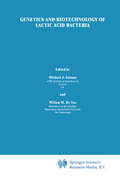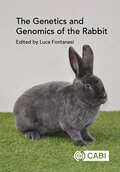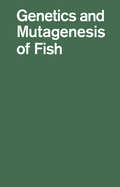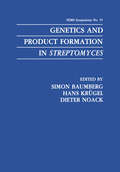- Table View
- List View
Genetic Engineering: Principles and Methods (Genetic Engineering: Principles and Methods #18)
by Jane K. SetlowVolume 18 explores the latest advances in recombinant DNA molecule techniques and how they are revolutionizing basic research in biology. Chapters discuss obtaining good expression of genetically engineered pest-resistant genes introduced in crop plants, cloning DNAs containing palindromes, and identifying genes by 3' terminal exon trapping and much more.
Genetic Engineering: Principles and Methods (Genetic Engineering: Principles and Methods #12)
by Jane K. SetlowGenetic Engineering: Principles and Methods (Genetic Engineering: Principles and Methods #14)
by Jane K. SetlowGenetic Engineering: Reading, Writing and Editing Genes (essentials)
by Röbbe WünschiersThis essential should serve as an introduction for a contemporary public discussion on genetic engineering. Genetic engineering affects us all in many areas and we must dare to think more colorful and further. In fact, the complete genetic material of viruses and bacteria can already be chemically produced and "brought to life". With genetic surgery, medicine is at a crossroads: do we want to treat hereditary diseases or "repair" them genetically? And the analysis of thousands of human genetic material reveals information that is related to complex diseases, but also to characteristics such as intelligence. How should we use this knowledge? The question is hardly whether we want genetic engineering, but rather how we use it.This Springer essential is a translation of the original German 1st edition essentials, Gentechnik by Röbbe Wünschiers, published by The Editor(s) (if applicable) and The Author(s), under exclusive license to Springer Fachmedien Wiesbaden GmbH, part of Springer Nature in 2019. The translation was done with the help of artificial intelligence (machine translation by the service DeepL.com). A subsequent human revision was done primarily in terms of content, so that the book will read stylistically differently from a conventional translation. Springer Nature works continuously to further the development of tools for the production of books and on the related technologies to support the authors.
Genetic Engineering for Nitrogen Fixation (Basic Life Sciences #9)
by Alexander HollaenderThere is a time in scientific research when a number of developments coincide making it possible to progress with a tough and complicated problem. It is believed that such a time has come in the area of biological nitrogen fixation. A better understanding of photosynthesis, cell hybridization, plasmid, and gene transfer between cells not necessarily genetically related, have opened new avenues of research. New developments in traditional genetics, cell biology, biochemistry, including enzyme chemistry, and plant physi ology have brought about the feeling this is a most appro priate time to pull together the different approaches in a conference where the lines of research could be discussed and thus help to speed up developments in this area. What makes biological nitrogen fixation especially im portant is the promise that a good understanding of the basic problem would help us to make organisms more amenable to fix nitrogen, not only in symbiosis with legumes, but also with other plant species and develop a wider variety of organisms with the ability to fix N • It will also 2 encourage a search for naturally occurring N2 fixing organ isms other than the traditional N2 fixers. Some success has already been encountered in this area. Success in broadening the field of nitrogen fixing would help to increase food supply, especially in de veloping countries which cannot afford to purchase synthetic nitrogen sources.
Genetic Engineering in Livestock: New Applications and Interdisciplinary Perspectives (Ethics of Science and Technology Assessment #34)
by Margret Engelhard Kristin Hagen Matthias BoysenUpcoming applications of genetic engineering in farm animals include higher yields, leaner meat, or disease resistance. The proceedings cover an analysis of the state of the art of the technology and its applications, an introduction to the specific application zoopharming (a method to produce biopharmaceuticals in transgenic livestock), including an analysis of the market for biopharmaceuticals. In addition an assessment of ethical aspects of livestock biotechnology and considerations regarding animal welfare implications are covered. The study is addressed to science, industry and politics.
Genetic Engineering of Animals: An Agricultural Perspective (Basic Life Sciences #161)
by J. EvansJ. Warren Evans Department of Animal Science Texas A&M University College Station, Texas 77843 In the near future, improvement of domestic animals for the production of food and fiber is poised to undergo a revolution by the utilization of recent breakthroughs and advances in molecular genetics, embryo manipula tions, and gene transfer systems. Utilization of these techniques will have a wide impact on animal agriculture by improvement of production effi ciency via manipulation and control of many physiological systems. The end result will be to decrease production costs, increase food production and quality, and lower food costs. Health and well being of domestic and other animals will be improved as a result of new methods of disease diagnosis, vaccine production, and disease prevention practices. Genetic engineering also offers the possibility of utilizing animals for the development of pharmaceutical products to benefit society. Research progress will be en hanced via manipulation of the gene pool. The objectives of this Conference were to discuss the current status of animal bioengineering and to realistically assess the potential applica tions of current and future genetic technologies for the production of food and fiber to meet the needs of our hungry world, and to provide animal sci entists who may wish to utilize bioengineering in current or future re search programs with current background information regarding concepts, ap plications, and methodologies.
Genetic Engineering of Mesenchymal Stem Cells
by Jan A. NoltaMSC (mesenchymal stem cells) have been reported to initiate revascularization after injury, to facilitate engraftment of blood-forming stem cells, and to reduce the incidence of graft-vs. host disease through their immune-suppressive qualities. Finally, bone marrow-derived MSC have been reported to home to areas of solid tumor revascularization, and thus may be used as delivery vehicles to target ablative agents into dividing tumor cells. Recently the characteristics of human MSC from adipose (fat) tissue have also been identified. The possibility of repairing tissues, speeding stem cell engraftment, and targeting solid tumors for specific killing, using MSC easily harvested from bone marrow, or better yet, from unwanted fat tissue, holds broad appeal, and is an intriguing possibility that could have dramatic effect on health care. This book has information on how to isolate, grow, and characterize MSC from marrow and fat, and gives important insight into how these cells may be used for gene delivery and cellular therapies in the future. Updates on emerging clinical trials are given.
Genetic Improvement of Farmed Animals
by Geoff Simm Dr Geoff Pollott Raphael A Mrode Professor Ross Houston Dr Karen MarshallGenetic Improvement of Farmed Animals provides a thorough grounding in the basic sciences underpinning farmed animal breeding. Relating science to practical application, it covers all the major farmed animal species: cattle, sheep, goats, poultry, pigs and aquaculture species. The book: - Provides comprehensive coverage - from fundamental genetics, analysis of variation, prediction of breeding values and response to selection, through to application of modern genomics and biotechnology. - Illustrates the practical application of theory in temperate and tropical systems. - Outlines current practice and explores future directions, including sustainability and ethical implications, to leave readers completely up to date. Based on the previous bestseller, Genetic Improvement of Cattle and Sheep, this book has been completely revised, expanded and redesigned to be an essential textbook for undergraduate, masters and other early postgraduate-level students in agriculture, animal and veterinary science, as well as breeders, farmers, industry technical staff, advisors and extension workers.
Genetic Management of Fragmented Animal and Plant Populations
by Richard Frankham Jonathan D. Ballou Katherine Ralls Mark Eldridge Michele R. Dudash Charles B. Fenster Robert C. Lacy Paul SunnucksOne of the greatest unmet challenges in conservation biology is the genetic management of fragmented populations of threatened animal and plant species. More than a million small, isolated, population fragments of threatened species are likely suffering inbreeding depression and loss of evolutionary potential, resulting in elevated extinction risks. Although these effects can often be reversed by re-establishing gene flow between population fragments, managers very rarely do this. On the contrary, genetic methods are used mainly to document genetic differentiation among populations, with most studies concluding that genetically differentiated populations should be managed separately, thereby isolating them yet further and dooming many to eventual extinction! Many small population fragments are going extinct principally for genetic reasons. Although the rapidly advancing field of molecular genetics is continually providing new tools to measure the extent of population fragmentation and its genetic consequences, adequate guidance on how to use these data for effective conservation is still lacking. This accessible, authoritative text is aimed at senior undergraduate and graduate students interested in conservation biology, conservation genetics, and wildlife management. It will also be of particular relevance to conservation practitioners and natural resource managers, as well as a broader academic audience of conservation biologists and evolutionary ecologists.
Genetic Mechanisms of Speciation in Insects: Symposia held at the XIVth International Congress of Entomology, Canberra, Australia August 22–30, 1972, sponsored by the Australian Academy of Science and the Australian Entomological Society
by M. J. D. WhiteTwo Symposia on speciation in insects held at the Fourteenth International Congress of Entomology (Canberra, Australia, August 22-30, 1972) are included in this volume. The first, on the more general topic of Genetic Analysis of Speciation Mechanisms, includes four papers on speciation in various groups of Diptera and Orthopteroid insects. The second symposium was devoted to the topic of Evolution in the Hawaiian Drosophilidae; it deals with the explosive speciation of a group of flies with specialized ecological requirements in the complex ecolOgical habitats provided by a recent tropical volcanic archipelago. The Hawaiian Symposium, organized by Professor D. Elmo Hardy, is the latest outcome of a major collaborative research project involving over 20 scientists and about 125 technical assistants over a period of ten years. Some recent books on evolution have taken the standpoint that the funda mental genetic mechanism of speciation is relatively uniform and stereotyped and, in particular, that the 'allopatric' model of its geographic component is universally valid. Certainly, this has been a rather generally accepted viewpoint on the part of students of vertebrate speciation. Workers on speciation in insects have tended, in general, to be less dogmatic and more willing to consider a variety of alternative models of speciation. Thus, in the present volume, several contributions adopt viewpoints which are unorthodox or novel. Only time will tell whether their conclusions will turn out to have been soundly based.
Genetic Mosaics and Cell Differentiation (Results and Problems in Cell Differentiation #9)
by W. J. GehringThe relationship of cell lineage and differentiation is one of the most intriguing problems in developmental biology. In most higher organisms, the analysis of the cell lineage has to rely on indirect methods. Only in the most suitable systems, like the nematodes, can the pattern of cell division be determined by direct observation under the microscope. In cases where this is not possible, the fate of the cells has to be examined by using cell markers. Most suitable for this purpose are genetic markers, provided that they do not interfere with the developmental pathway to be studied. However, suitable genetic markers and techniques for generating genetic mosaics are available in a few organisms only. Therefore, this volume is largely concerned with Drosophila and the mouse, which have been studied most extensively. In 1929 STURTEVANT introduced the analysis of gynandromorphs into devel opmental genetics. However, this important contribution remained largely unnoticed until the late sixties, when the potential of this technique for deter mining embryonic fate maps and the number of primordial cells was exploited, and the methodology extended to the mapping of mutational foci. Mitotic recombination was demostrated by STER:-< in 1936, who realized the potential of this technique for the analysis of cell lineage and pattern formation. The usefulness of this method was substantially increased by the discovery of FRIESEN that mitotic recombination can be induced by x-irradiation. This allows the induction of mosaicism at any stage of development.
Genetic Resources of Neotropical Fishes
by Alexandre W. Hilsdorf Eric M. HallermanThe aim of this book is to systematize and discuss population genetic studies of freshwater fish in a region that harbors the greatest diversity of species among all inland water ecosystems. This volume explores the genetic evaluation for a number of orders, families and species of Neotropical fishes, and provides an overview on genetic resources and diversity and their relationships with fish domestication, breeding, and food production.
Genetic Structure and Local Adaptation in Natural Insect Populations: Effects of Ecology, Life History, and Behavior
by Susan Mopper Sharon Y. StraussProviding an essential foundation for evolutionary theory, this comprehensive volume examines patterns of genetic variation within natural insect populations, and explores the underlying mechanisms that lead to the genetic divergence of coexisting organisms. In particular, the text investigates current research on finescale genetic structure in natural insect populations. Internationally renowned scientists offer a wealth of current information not previously published. Part I present case studies of adaptive genetic structure in natural insect populations, including a critical discussion of the strenghts and weaknesses of the experimental methods employed. Part II addresses the ecological mechanisms that produce adaptive genetic structure in natural insect populations. Part III describes how behavioral and life-history patterns influence genetic structure. Finally, Part IV combines theoretical and empirical approaches linking genetic structure at the population level with larger-scale patterns of variation, such as host race formation and speciation. This broad-ranging, interdisciplinary source of information supplies a thorough examination of the mechanisms that promote and impede genetic structure in natural insect populations. It is a book that will be of interest to undergraduate and graduate students, and to researchers in the fields of ecology, evolution, insect and plant systems, entomology, and population genetics.
Genetic Susceptibility to Cancer (Developments in Oncology #79)
by Seymour GarteDespite recent progress in many areas of treatment and control, cancer remains a frightening threat to everyone. While scientists have known for decades that the majority of human cancers are caused by environmental agents such as radiation and the chemicals in cigarette smoke, not everyone who smokes gets lung cancer. Furthermore, many people who assiduously avoid all possible risk from smoking, diet, and pollution still succumb to some form of cancer later in life. Does this mean that there is an element of blind chance in the underlying mechanisms of human carcinogenesis? To what extent do genetic influences play a role in determining the cancer risk of individuals? A number of `cancer families', in which several closely related individuals have suffered from various specific forms of cancer, have been studied by genetic epidemiologists. However, for the majority of cancer cases, little or no discernible genetic influence or family history is found. Recent research has discovered that for many of these `sporadic' (non-familial) cancer cases, defects or aberrations in certain metabolic genes not previously associated with genetic cancer risk may contribute to either causing the disease or at least increasing the chances of developing cancer. It is therefore possible that much of what has previously passed for `bad luck' may turn out to be a new type of `bad genes'. Genetic Susceptibility to Cancer explains that this new idea of `bad genes' may contain an unexpected positive side. The carcinogenic effects of these metabolic genes, unlike those of the oncogenes and tumor suppressor genes that are responsible for the inherited cancer syndromes, can potentially be overcome or nullified. Genetic Susceptibility to Cancer will provide a valuable reference for health professionals, researchers, clinicians and biomedical scientists who are interested in the current thinking in this critically important area of cancer management.
Genetic Toxicology: An Agricultural Perspective (Basic Life Sciences #21)
by Raymond F. FleckTo meet the needs of an ever-growing world population for food and fiber, agriculture uses an arsenal of chemicals to control insects, weeds and other pests that compete with man in the agricultural arena. In addition to their intended effect, many of these biologically active materials affect non-target organisms including man himself. There is concern about the resulting occupational exposure of those who work in agriculture and the environmental health of those who live in rural areas. Unintended side effects from the use of agricultural chemicals are further complicated by the dispersal of these substances well beyond the area of immediate use, through food chains, atmospheric transport, irrigation runoff, percolation to and diffusion through ground water, sometimes giving rise to public health and environmental problems at a distance from the place of application. In addition to toxic substances introduced into the agro ecosystem by man, one must be concerned about naturally occurring agents including mfcotoxins, plant poisons, infective biological agents and the levels of certain heavy metals. The formation of toxic substances, many of them mutagenic, during cooking and other processing of food is a related problem. While acute effects are more immediate and somewhat readily discerned, chronic and genetic effects tend to be more obscure and sometimes surface in a crisis situation long after substantial damage has been sustained. Genotoxicity assays and epidemiological studies play increasing roles in predicting and evaluating long term effects of low-level exposure to toxic materials.
Genetically Modified and other Innovative Vector Control Technologies: Eco-bio-social Considerations for Safe Application
by Brij Kishore TyagiThis book comprehensively covers the latest development in developing and deploying the genetically modified vectors, particularly Anopheles and Aedes mosquitoes responsible for transmitting malaria parasites and dengue viruses, the most deadly and/or debilitating among all the vector-borne diseases. It is considered timely and commensurate to bring about a book dealing with the various ecological, biological and social as well as regulatory aspects for the deployment of genetically modified vectors in special context with the biosafety of humans, his associates, and the environment. Written by an array of specialists and experts in various subjects of genetically modified organisms, this book centrally addresses the (i) basic principles of the genetic manipulation of vectors and they are potential impact on human and the environment, (ii) ecological, biological, ethical, legal and social implications of the use of genetically modified vectors, (iii) identification of potential hazards; assessment and management of risks for human and environment; risk/benefit analysis, (iv) principles and practices for the assessment and management of biosecurity and biosafety in laboratories (and in the field), (v) guiding principles for creation and management of institutional or national biosafety review boards and ethics review committees, and (vi) development and application of a biosafety regulatory framework and its related legal principles at national levels for securing the development and use of vector control methods based on genetic modification strategies. This publication will be useful to researchers, scientists, and professionals engaged in academic and research institutions, government or non-government, as well as students in universities and medical colleges.
Genetics and Auditory Disorders (Springer Handbook of Auditory Research #14)
by Bronya J. B. Keats Richard R. FayGenetics is fundamental to hearing function, and an understanding of genetics enhances both auditory research and the clinical treatment of the hearing impaired. Approaches to the diagnosis and treatment of hearing impairment have developed from technological advances in genetic research. This volume covers gene expression, mutations, mapping and cloning, as well as mitochondrial and cellular genetics. Chapters are also included on the uses of mouse models, genetic epidemiology and genetic counseling specifically for hearing impairment. As a comprehensive review of the genetics of hearing, this book will interest hearing researchers, clinicians and genetic counselors.
Genetics and Biotechnology of Lactic Acid Bacteria
by Michael J. Gasson Willem M. De VosA prime reference volume for geneticists, food technologists and biotechnologists in the academic and industrial sectors. Fermentations with lactic acid bacteria determine important qualities such as taste, shelf-life, and food values. New methods of food production require fast and reliable manufacture, which has led to a dramatic surge of interest in the genetic, microbiological and biochemical properties of lactic acid bacteria.
The Genetics and Genomics of the Rabbit
by Domenico Spina Cristiano Boiti Bernd Fischer Jianglin Fan Zsuzsanna Bosze Joana Abrantes Marielle Afanassieff Daniel Allain Andre Almeida Susana S. Araújo Manuel Baselga Agustin Blasco Paul Boettcher Gerard Bolet Darko Bosnakovski Samuel Boucher Samuele Bovo Gudrun A. Brockmann Luca Buttazzoni Cesare Castellini Pascale Chavatte-Palmer Peter Chrenek Veronique Duranthon Pedro José Esteves María-Luz García Hervé Garreau Elen Gócza Mélanie Gunia Pilar Hernández László Hiripi Arata Honda Adriana Kolesárová Ana Lemos de Matos Rose Mage Manolis Matzapetakis István Nagy Clive Page Mariana Palma Miriam Piles Andrea Rau Andreas Ritsch Claire Rogel-Gaillard Jun Pablo Sanchez Maria Antonia Santacreu Pierre Savatier Giuseppina Schiavo Ina Sternstein Zsolt Szendro Valerio Joe UtzeriRabbits have many uses - as well as being cherished pets, they are bred for their meat and fur, and as laboratory animals. Understanding their genetics and genomics is key to their production and, equally, to their care, welfare and health. Beginning with an introduction to the rabbit, including key information on their evolution, domestication and breed types, this book then concentrates on the genetics and genomics of this valuable animal. This book covers: - Cytogenetics, genetic maps and QTL mapping; - Immunogenetics; - Genetics of coat colour, meat, fibre and fur production, reproduction, disease resistance and more. Concluding with practical applications such as creating transgenic and genome edited rabbits, biotechnical applications and the rabbit as a biomedical model, this book brings this important topic fully up-to-date. It provides an indispensable resource for animal and veterinary researchers and students, as well as rabbit breeders and laboratory scientists.
Genetics and Mutagenesis of Fish: Dedicated to Curt Kosswig on his 70th Birthday
by Johannes Horst SchröderGenetics and Product Formation in Streptomyces (F.E.M.S. Symposium Series #55)
by Simon Baumberg Hans Krügel Dieter NoackThe Streptomycetes are industrially widely used microorganisms due to their ability to produce numerous different chemical compounds. These show very varied effects upon other living systems, and result from profound and subtle biochemical and morphological differentiation during the streptomycete life cycle. It is therefore not surprising that research on the genetics of antibiotic biosynthesis and differentiation in this group is currently progressing rapidly in many countries. Intimately connected with the production of antibiotics is resistance to them; analysis of this is giving further information about the origin and evolution of this class of genes and their hypothesized spread among other microorganisms. Another interesting feature of the Streptomyces group is their mycelial growth. Also, their ecologically important utilization of high molecular weight compounds requires enzymes to be transported outside the cell to hydrolyze non-diffusible substrates. Finally, we have as yet limited understanding of the various mechanisms of genome rearrangement observed in some of these species; deletions and/or amplifications of enormous amounts of DNA can occur without seriously affecting the viability of the organism under laboratory conditions. The present volume, which includes contributions addressing the above subjects and others, originates from a meeting on "Genetics and Product Formation in Streptomyces" sponsored by the Federation of European Microbiological Societies in Erfurt on May 1-6 1990. Compared to previous ones of this kind held in 1979, 1983 and 1987 in Weimar, one can point to impressive progress in the study and applications of Streptomyces genetics.
